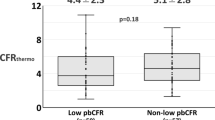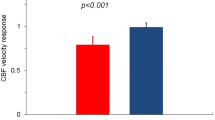Abstract
We investigated the effect of β- and α-adrenergic blockers on fractional flow reserve (FFR) and index of microvascular resistance (IMR). In 43 patients (pts) with intermediate stenoses, we measured FFR and IMR before and after nonselective β-blocker propranolol (30 μg/kg, n = 20) and selective β1-blocker metoprolol (40 μg/kg, n = 23) IC; (b) In additional 21 pts after percutaneous coronary intervention (PCI), FFR and IMR were measured before and after α-blocker phentolamine (3 mg) IC. Neither propranolol nor metoprolol changed values of FFR and IMR. Phentolamine slightly decreased FFR (from 0.88 ± 0.05 to 0.87 ± 0.06, p = 0.025) but did not change IMR. FFR decreased from >0.80 to ≤0.80 in 3 pts (14 %), but in none, the value decreased to <0.75. β-blockers do not affect FFR and IMR in intermediate stenoses. After PCI, a mild decrease in FFR occurs after α-blockers, though of limited clinical impact.



Similar content being viewed by others
References
Mangiacapra, F., & Barbato, E. (2011). From SYNTAX to FAME, a paradigm shift in revascularization strategies: the key role of fractional flow reserve in guiding myocardial revascularization. Journal of Cardiovascular Medicine (Hagerstown, Md.), 12, 538–542.
De Bruyne, B., Fearon, W. F., Pijls, N. H., et al. (2014). Fractional flow reserve-guided PCI for stable coronary artery disease. New England Journal of Medicine, 371(13), 1208–1217.
Hamilos, M., Muller, O., Cuisset, T., et al. (2009). Long-term clinical outcome after fractional flow reserve-guided treatment in patients with angiographically equivocal left main coronary artery stenosis. Circulation, 120, 1505–1512.
Ntalianis, A., Sels, J. W., Davidavicius, G., et al. (2010). Fractional flow reserve for the assessment of nonculprit coronary artery stenosis in patients with acute myocardial infarction. Journal of the American College of Cardiology: Cardiovascular Interventions, 3, 1274–1281.
Muller, O., Mangiacapra, F., Ntalianis, A., et al. (2011). Long-term follow-up after fractional flow reserve-guided treatment strategy in patients with an isolated proximal left anterior descending coronary artery stenosis. Journal of the American College of Cardiology: Cardiovascular Interventions, 4, 1175–1182.
Puymirat, E., Peace, A., Mangiacapra, F., et al. (2012). Long-term clinical outcome after fractional flow reserve-guided percutaneous coronary revascularization in patients with small-vessel disease. Circulation. Cardiovascular Interventions, 5, 62–68.
Fearon, W. F., Aarnoudse, W., Pijls, N. H., et al. (2004). Microvascular resistance is not influenced by epicardial coronary artery stenosis severity: experimental validation. Circulation, 109, 2269–2272.
Aarnoudse, W., Fearon, W. F., Manoharan, G., et al. (2004). Epicardial stenosis severity does not affect minimal microcirculatory resistance. Circulation, 110, 2137–2142.
Melikian, N., Vercauteren, S., Fearon, W. F., et al. (2010). Quantitative assessment of coronary microvascular function in patients with and without epicardial atherosclerosis. EuroIntervention, 5, 939–945.
Mangiacapra, F., De Bruyne, B., Peace, A. J., Melikian, N., Wijns, W., & Barbato, E. (2012). High cholesterol levels are associated with coronary microvascular dysfunction. Journal of Cardiovascular Medicine (Hagerstown, Md.), 13, 439–442.
Pijls, N. H., Klauss, V., Siebert, U., et al. (2002). Fractional Flow Reserve (FFR) Post-Stent Registry Investigators. Coronary pressure measurement after stenting predicts adverse events at follow-up: a multicenter registry. Circulation, 105, 2950–2954.
Nam, C. W., Hur, S. H., Cho, Y. K., et al. (2011). Relation of fractional flow reserve after drug-eluting stent implantation to one-year outcomes. American Journal of Cardiology, 107, 1763–1767.
Barbato, E. (2009). Role of adrenergic receptors in human coronary vasomotion. Heart, 120, 1505–1512.
Kern, M. J., Horowitz, J. D., Ganz, P., et al. (1985). Attenuation of coronary vascular resistance by selective alpha 1-adrenergic blockade in patients with coronary artery disease. Journal of the American College of Cardiology, 5, 840–846.
Julius, B. K., Vassalli, G., Mandinov, L., & Hess, O. M. (1999). Alpha-adrenoceptor blockade prevents exercise-induced vasoconstriction of stenotic coronary arteries. Journal of the American College of Cardiology, 33, 1499–1505.
Baumgart, D., Haude, M., Gorge, G., et al. (1999). Augmented α-adrenergic constriction of atherosclerotic human coronary arteries. Circulation, 99, 2090–2097.
Barbato, E., Bartunek, J., Wyffels, E., Wijns, W., Heyndrickx, G. R., & De Bruyne, B. (2003). Effects of intravenous dobutamine on coronary vasomotion in humans. Journal of the American College of Cardiology, 42, 1596–1601.
Barbato, E., Piscione, F., Bartunek, J., et al. (2005). Role of beta2 adrenergic receptors in human atherosclerotic coronary arteries. Circulation, 111, 288–294.
Gregorini, L., Fajadet, J., Robert, G., Cassagneau, B., Bernis, M., & Marco, J. (1994). Coronary vasoconstriction after percutaneous transluminal coronary angioplasty is attenuated by antiadrenergic agents. Circulation, 90, 895–907.
Gregorini, L., Marco, J., Kozàkovà, M., et al. (1999). α-adrenergic blockade improves recovery of myocardial perfusion and function after coronary stenting in patients with acute myocardial infarction. Circulation, 99, 482–490.
Gregorini, L., Marco, J., Farah, B., et al. (2002). Effects of selective α1- and α2-adrenergic blockade on coronary flow reserve after coronary stenting. Circulation, 106, 2901–2907.
Gregorini, L., Marco, J., & Heusch, G. (2012). Peri-interventional coronary vasomotion. Journal of Molecular and Cellular Cardiology, 52, 883–889.
Kern, M. J., Ganz, P., Horowitz, J. D., et al. (1983). Potentiation of coronary vasoconstriction by beta-adrenergic blockade in patients with coronary artery disease. Circulation, 67, 1178–1185.
Kern, M. J., Petru, M. A., Ferry, D. R., et al. (1985). Regional coronary vasoconstriction after combined beta-adrenergic and calcium channel blockade in patients with coronary artery disease. Journal of the American College of Cardiology, 5, 1438–1450.
Hodgson, J. M., Cohen, M. D., Szentpetery, S., & Thames, M. D. (1989). Effects of regional alpha- and beta-blockade on resting and hyperaemic coronary blood flow in conscious, unstressed humans. Circulation, 79, 797–809.
Bortone, A. S., Hess, O. M., Gaglione, A., et al. (1990). Effect of intravenous propranolol on coronary vasomotion at rest and during dynamic exercise in patients with coronary artery disease. Circulation, 81, 1225–1235.
Barbato, E., Bartunek, J., Aarnoudse, W., et al. (2004). Alpha-adrenergic receptor blockade and hyperaemic response in patients with intermediate coronary stenoses. European Heart Journal, 25, 2034–2039.
Aarnoudse, W., Geven, M., Barbato, E., Botman, K.-J., De Bruyne, B., & Pijls, N. H. J. (2005). Effect of phentolamine on the hyperemic response to adenosine in patients with microvascular disease. American Journal of Cardiology, 96, 1627–1630.
Penicka, M., Bartunek, J., Wijns, W., et al. (2004). Tissue doppler imaging predicts recovery of left ventricular function after recanalization of an occluded coronary artery. Journal of the American College of Cardiology, 43(1), 85–91.
Zarins, C. K., Taylor, C. A., & Min, J. K. (2013). Computed fractional flow reserve (FFTCT) derived from coronary CT angiography. Journal of Cardiovascular Translational Research, 6(5), 708–714.
De Bruyne, B., Pijls, N. H., Barbato, E., et al. (2003). Intracoronary and intravenous adenosine 5′-triphosphate, adenosine, papaverine, and contrast medium to assess fractional flow reserve in humans. Circulation, 107, 1877–1883.
Bottcher, M., Johannes, C., San, K., Phelps, E., & Schelbert, H. (1997). Effect of β1-adrenergic receptor blockade on myocardial blood flow and vasodilatory capacity. Journal of Nuclear Medicine, 38, 442–446.
Billinger, M., Seiler, C., Fleisch, M., Eberli, F. R., Meier, B., & Hess, O. M. (2001). Do beta-adrenergic blocking agents increase coronary flow reserve? Journal of the American College of Cardiology, 38, 1866–1871.
Gan, L. M., Wikström, J., & Fritsche-Danielson, R. (2013). Coronary flow reserve from mouse to man–from mechanistic understanding to future interventions. Journal of Cardiovascular Translational Research, 6(5), 715–728.
Ozdemir, M., Erdem, G., Yazici, I., Turkoglu, S., Timurkaynak, T., & Cengel, A. (2007). Metoprolol does Not Effect Myocardial Fractional Flow Reserve in Patients with Intermediate Coronary Stenoses. International Heart Journal, 48, 477–483.
Conflicts of Interest
No conflict of interest with the topic investigated.
Author information
Authors and Affiliations
Corresponding author
Additional information
Associate Editor Angela Taylor oversaw the review of this article
Rights and permissions
About this article
Cite this article
Barbato, E., Sarno, G., Berza, C.T. et al. Impact of Alpha- and Beta-Adrenergic Receptor Blockers on Fractional Flow Reserve and Index of Microvascular Resistance. J. of Cardiovasc. Trans. Res. 7, 803–809 (2014). https://doi.org/10.1007/s12265-014-9599-8
Received:
Accepted:
Published:
Issue Date:
DOI: https://doi.org/10.1007/s12265-014-9599-8




